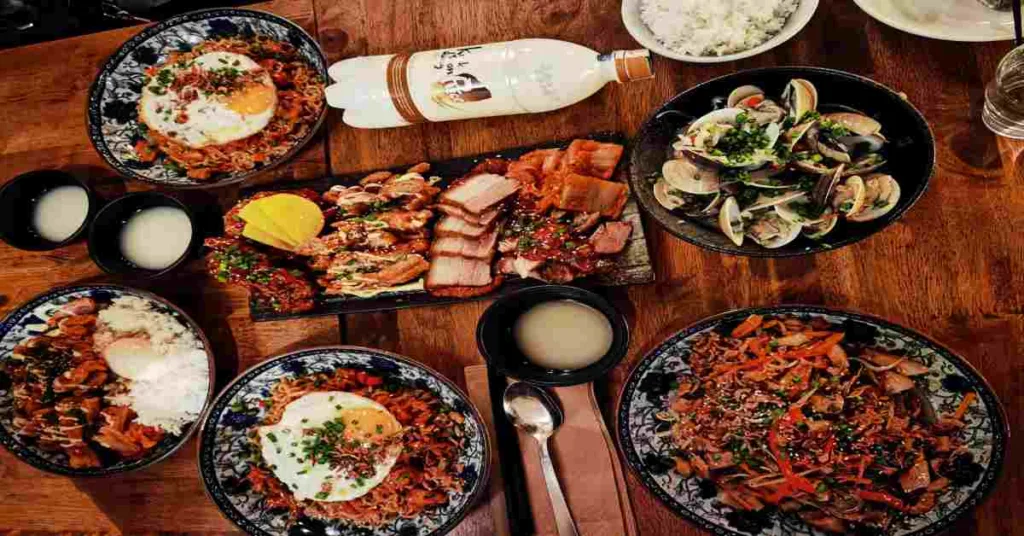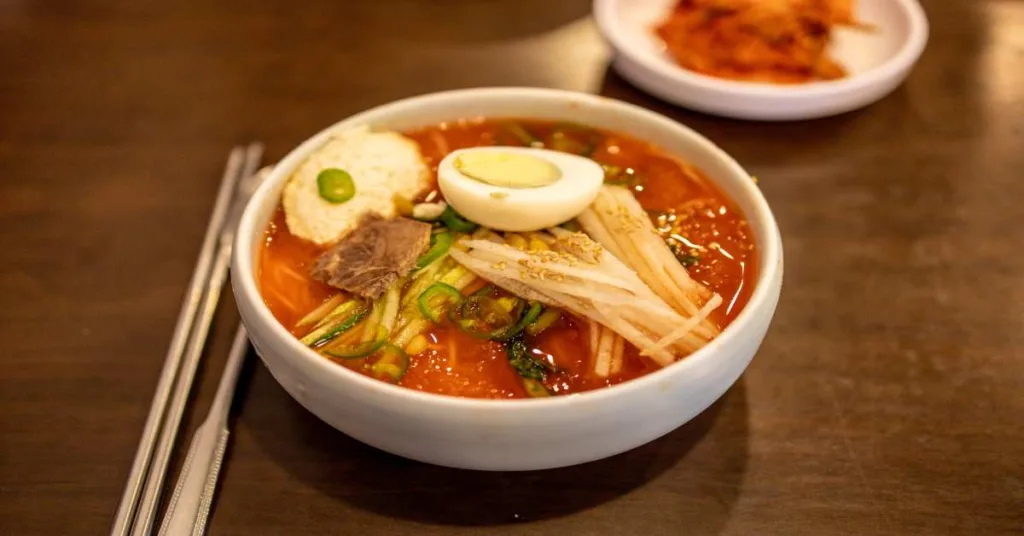Zha Jiang Mian is a well-known traditional Beijing cuisine that consists of ground pork and onion cooked in a rich, savory brown sauce with a hint of sweetness. Noodles are then added, and the dish is finished with crunchy cucumber. It can be made ahead of time, requires little preparation, and cooks quickly. It’s the ideal one-bowl dinner for warm days and works well for meal preparation.
What is Zha Jiang Mian?
One of the most well-liked Shandong Cuisine dishes is Zhajiangmian (fried sauce noodles). It is a meal of substantial wheat noodles with zhajiang sauce on top. Pork or beef is simmered in a sauce consisting of salty, fermented soybean paste. Zhajiang and mian are both Chinese words that translate to “fried sauce” and “noodles,” respectively. It is also a well-known mini lunch or snack in Beijing.
Zhajiangmian originated in Shandong and was presented to Beijing by Qing Dynasty Emperor Guangxu (1871–1908) and Empress Dowager Cixi when travelling from Beijing to Xi’an. They entered a restaurant and placed a bowl of Zhajiangmian on the menu. They both had to have another bowl because it was so delicious. Then, Empress Dowager Cixi invited the cook who had prepared the “fried sauce noodles” to the Beijing palace. Zhajiangmian gained popularity in Beijing and other parts of China ever since.
Even though the meal originated in China, it was popularised in Korea 100 years ago after being brought there by Shandong immigrants. Because it is inexpensive, practical, and informal, the dish, known as ja jang myun in Korea, is incredibly well-liked.
The dish’s Zha Jiang sauce is its primary selling point. Ground beef and a yellow soybean paste are used to make the sauce. Typically, sweet bean sauce and soybean paste are used as the basic sauce for Beijing Style Zha Jiang Mian.
The meal also comes in a vegetarian variation where the beef is replaced with smoked tofu when making the sauce. These noodles are quite salty and fragrant. They are referred to in Beijing as “soul food” for this reason.
Zha Jiang Mian is traditionally cooked in Beijing using handmade noodles. With a rolling pin, a firm dough (made of all-purpose flour, water, and a dash of salt) is rolled flat before being cut into long, thick noodles. To accomplish the same thing, a pasta machine will come in helpful.
Depending on the location, sliced fresh or pickled vegetables, such as cucumber, radish, and pickled edamame, are frequently used as a topping for noodles. Additionally, extra firm tofu or a chopped omelette might be served. Low-fat dieters frequently use skinless, minced chicken for the meat component.
Out of all the variations of Zha Jiang Mian, I favour the Beijing variation where the primary seasoning is yellow soybean paste (sweet bean sauce, hoisin sauce or broad bean sauce are used in other versions).
With wheat, salt, water, and fermented yellow soybeans, yellow soybean paste is a dark, thick paste. It is Beijing Zha Jiang Mian’s soul, pungent, fragrant, and salty. It comes in two varieties: standard and dry yellow soybean paste. Its texture is more substantial since it has less water in it.
Zha Jiang Mian places a high value on vegetables. To save as much nutrition as possible, they are either served raw or immediately blanched. This recipe has an excellent balance because the natural plain flavour of the veggies pairs nicely with the salty, fragrant sauce even without any additional seasoning.
You can top your dish with a variety of vegetables, including carrot, celery, cucumber, beansprouts, radish, fresh green soybeans, Chinese cabbage, and any other veggies with a crisp texture.
Which type of Noodles is best for Zha Jiang Mian?
The noodles used in traditional Zha Jiang Mian are quite thick. In terms of thickness, it is comparable to udon noodles but has a chewier texture.
If all you can find are dried noodles, that is perfectly acceptable. Depending on the texture you desire, you can use either thick or thin types of noodles. Use wheat flour and water-based noodles; no other components, such as eggs, should be present.
Difference between Korean & Chinese Zha Jiang Mian
It is widely acknowledged that Zhajiangmian, a Chinese word, is the source of jjajangmyeon. While both meals feature thick meat sauces and tossed noodles, Zhajiangmian typically utilises soybean paste while the Korean dish employs fermented black bean paste.
Zha Jiang Mian Recipe
Ingredients: Noodles
For the sauce: Dry yellow soybean paste, Sweet bean sauce, water, oil, star anise, scallion, ginger, pork, and rice wine.
For the vegetables: Bean sprouts, soybean, cucumber, radish.
Step 1: Dry yellow soybean paste and sweet bean sauce should be diluted with water in a bowl. Place aside.
Step 2: Oil in a wok is heated over medium-high heat. Ginger, spring onions (the green part), and star anise should be added. Continually stir until fragrant.
Step 3: Add the rice wine and the pork. Cook the pork until it turns pale.
Step 4: The diluted sauce should be added. After bringing everything to a boil, let it simmer for 20 minutes.
Step 5: The sauce will then thicken to the desired consistency after a full boil. Add the scallions’ white portion and stir.
Step 6: Boiling water is used to blanch green soybeans and beansprouts (cucumber and radish are served raw). Drain when you take them out.
Step 7: Noodles can be prepared in the same pot. Drain and give a quick rinse with cold water.
Step 8: Serve the noodles in a bowl. Add the sauce and vegetables on top.
TIPS:
- Use a piece of pork with some fat for enhanced flavour. If you choose, you are welcome to replace minced pork. Additionally, the major ingredient could be beef, lamb, chicken, tofu, or shiitake mushrooms.
- Feel free to top it with additional vegetables of your choice. Also excellent are Chinese cabbage, carrots, and celery.


